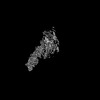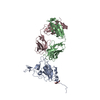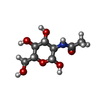[English] 日本語
 Yorodumi
Yorodumi- PDB-9ccj: Dissecting human monoclonal antibody responses from mRNA and prot... -
+ Open data
Open data
- Basic information
Basic information
| Entry | Database: PDB / ID: 9ccj | ||||||
|---|---|---|---|---|---|---|---|
| Title | Dissecting human monoclonal antibody responses from mRNA and protein-based booster vaccinations against XBB1.5 SARS-CoV-2 | ||||||
 Components Components |
| ||||||
 Keywords Keywords | VIRAL PROTEIN/IMMUNE SYSTEM / SARS-CoV-2 / Antibody / NTD / IMMUNE SYSTEM / VIRUS LIKE PARTICLE / VIRAL PROTEIN-IMMUNE SYSTEM complex | ||||||
| Function / homology |  Function and homology information Function and homology informationsymbiont-mediated disruption of host tissue / Maturation of spike protein / Translation of Structural Proteins / Virion Assembly and Release / host cell surface / host extracellular space / viral translation / symbiont-mediated-mediated suppression of host tetherin activity / Induction of Cell-Cell Fusion / structural constituent of virion ...symbiont-mediated disruption of host tissue / Maturation of spike protein / Translation of Structural Proteins / Virion Assembly and Release / host cell surface / host extracellular space / viral translation / symbiont-mediated-mediated suppression of host tetherin activity / Induction of Cell-Cell Fusion / structural constituent of virion / membrane fusion / entry receptor-mediated virion attachment to host cell / Attachment and Entry / host cell endoplasmic reticulum-Golgi intermediate compartment membrane / positive regulation of viral entry into host cell / receptor-mediated virion attachment to host cell / host cell surface receptor binding / symbiont-mediated suppression of host innate immune response / receptor ligand activity / endocytosis involved in viral entry into host cell / fusion of virus membrane with host plasma membrane / fusion of virus membrane with host endosome membrane / viral envelope / symbiont entry into host cell / virion attachment to host cell / SARS-CoV-2 activates/modulates innate and adaptive immune responses / host cell plasma membrane / virion membrane / identical protein binding / membrane / plasma membrane Similarity search - Function | ||||||
| Biological species |  Homo sapiens (human) Homo sapiens (human) | ||||||
| Method | ELECTRON MICROSCOPY / single particle reconstruction / cryo EM / Resolution: 2.37 Å | ||||||
 Authors Authors | Bajic, G. / Civljak, A. | ||||||
| Funding support |  United States, 1items United States, 1items
| ||||||
 Citation Citation |  Journal: Lancet Microbe / Year: 2025 Journal: Lancet Microbe / Year: 2025Title: Mapping of human monoclonal antibody responses to XBB.1.5 COVID-19 monovalent vaccines: a B cell analysis. Authors: Raianna F Fantin / Jordan J Clark / Hallie Cohn / Deepika Jaiswal / Bailey Bozarth / Vishal Rao / Alesandro Civljak / Igor Lobo / Jessica R Nardulli / Komal Srivastava / Jeremy S Yong / ...Authors: Raianna F Fantin / Jordan J Clark / Hallie Cohn / Deepika Jaiswal / Bailey Bozarth / Vishal Rao / Alesandro Civljak / Igor Lobo / Jessica R Nardulli / Komal Srivastava / Jeremy S Yong / Robert Andreata-Santos / Kaitlyn Bushfield / Edward S Lee / Gagandeep Singh / / Steven H Kleinstein / Florian Krammer / Viviana Simon / Goran Bajic / Camila H Coelho /    Abstract: BACKGROUND: The rapid emergence of highly transmissible and immune-evasive SARS-CoV-2 variants has required the reformulation of COVID-19 vaccines to target these evolving threats. Although previous ...BACKGROUND: The rapid emergence of highly transmissible and immune-evasive SARS-CoV-2 variants has required the reformulation of COVID-19 vaccines to target these evolving threats. Although previous infections and booster vaccinations can boost variant neutralisation, it remains uncertain whether monovalent vaccines-delivered via mRNA or protein-based platforms-can trigger novel B-cell responses specific to omicron XBB.1.5 variants. We sought to address this uncertainty by characterising the antibody repertoire of individuals receiving a monovalent booster vaccine. METHODS: In this observational study, we analysed the genetic antibody repertoire of 603 individual plasmablasts from five individuals (recruited at the Icahn School of Medicine at Mount Sinai, New ...METHODS: In this observational study, we analysed the genetic antibody repertoire of 603 individual plasmablasts from five individuals (recruited at the Icahn School of Medicine at Mount Sinai, New York, NY, USA, from STUDY-16-01215/IRB-16-00971 and STUDY-20-00442/IRB-20-03374) vaccinated with a monovalent XBB.1.5 vaccine, either through mRNA (Moderna or Pfizer-BioNTech; participants 1, 2, and 3) or adjuvanted protein (Novavax; participants 4 and 5) platforms. Before XBB.1.5 booster vaccination, all participants received mRNA-based priming and booster vaccine with ancestral SARS-CoV-2 and four of the five participants had a breakthrough omicron variant infection. We expressed 100 human monoclonal antibodies (mAbs; 50 from participants 1, 2, and 3, and 50 from participants 4 and 5) and evaluated their binding and neutralisation against various SARS-CoV-2 variants, including JN.1. We then selected four mAbs for in-vivo protection experiments by passive immunisation and viral challenge, and cryo-electron microscopy with two selected mAbs complexed with the XBB.1.5 spike (S) protein to determine their structures and binding interactions. FINDINGS: Between October and November, 2023, we enrolled three male and two female participants (mean age 46 years) all of whom were White. We identified 21 binding mAbs and tested their ...FINDINGS: Between October and November, 2023, we enrolled three male and two female participants (mean age 46 years) all of whom were White. We identified 21 binding mAbs and tested their neutralisation capacity against ancestral SARS-CoV-2, XBB.1.5, and JN.1. From the six neutralising mAbs we characterised, we selected three (M2, M27, and M39) for in-vivo protection studies, along with one broadly binding antibody (M15), finding that three neutralising mAbs offered full protection against morbidity from XBB.1.5. M27 also displayed robust protection against the ancestral and JN.1 strains, and M39 offered partial protection from JN.1. Among these, we identified two standout antibodies: M2 and M39. M2 was uniquely specific to XBB.1.5, and M39 demonstrated the ability to bind and neutralise both XBB.1.5 and JN.1 strains. Using high-resolution cryo-electron microscopy, we mapped the binding sites of M2 and M39 on the XBB.1.5 S glycoprotein, uncovering the precise molecular interactions that dictate their specificity. INTERPRETATION: Our findings offer key molecular insights into whether strain-specific boosters elicit sufficient protection against SARS-CoV-2 emerging variants. This knowledge can inform decisions ...INTERPRETATION: Our findings offer key molecular insights into whether strain-specific boosters elicit sufficient protection against SARS-CoV-2 emerging variants. This knowledge can inform decisions on booster design and strategies to enhance preparedness to evolving viral threats. FUNDING: Icahn School of Medicine at Mount Sinai; National Institutes of Health (NIH) FIRST; Laura and Isaac Perlmutter Cancer Center Support Grant; National Institute of Allergy and Infectious ...FUNDING: Icahn School of Medicine at Mount Sinai; National Institutes of Health (NIH) FIRST; Laura and Isaac Perlmutter Cancer Center Support Grant; National Institute of Allergy and Infectious Diseases; Human Immunology Project Consortium by NIH; the São Paulo Research Foundation; the National Heart, Lung, and Blood Institute of the NIH; Irma T Hirschl and Monique Weill-Caulier Trust; and the Collaborative Influenza Vaccine Innovation Centers. #1: Journal: bioRxiv / Year: 2024 Title: Dissecting human monoclonal antibody responses from mRNA- and protein-based XBB.1.5 COVID-19 monovalent vaccines. Authors: Raianna F Fantin / Jordan J Clark / Hallie Cohn / Deepika Jaiswal / Bailey Bozarth / Alesandro Civljak / Vishal Rao / Igor Lobo / Jessica R Nardulli / Komal Srivastava / Jeremy Yong / Robert ...Authors: Raianna F Fantin / Jordan J Clark / Hallie Cohn / Deepika Jaiswal / Bailey Bozarth / Alesandro Civljak / Vishal Rao / Igor Lobo / Jessica R Nardulli / Komal Srivastava / Jeremy Yong / Robert Andreata-Santos / Kaitlyn Bushfield / Edward S Lee / Gagandeep Singh / / Steven H Kleinstein / Florian Krammer / Viviana Simon / Goran Bajic / Camila H Coelho /    Abstract: The emergence of highly contagious and immune-evasive severe acute respiratory syndrome coronavirus 2 (SARS-CoV-2) variants has required reformulation of coronavirus disease 2019 (COVID-19) vaccines ...The emergence of highly contagious and immune-evasive severe acute respiratory syndrome coronavirus 2 (SARS-CoV-2) variants has required reformulation of coronavirus disease 2019 (COVID-19) vaccines to target those new variants specifically. While previous infections and booster vaccinations can enhance variant neutralization, it is unclear whether the monovalent version, administered using either mRNA or protein-based vaccine platforms, can elicit B-cell responses specific for Omicron XBB.1.5 variants. Here, we dissected the genetic antibody repertoire of 603 individual plasmablasts derived from five individuals who received a monovalent XBB.1.5 vaccination either with mRNA (Moderna or Pfizer/BioNtech) or adjuvanted protein (Novavax). From these sequences, we expressed 100 human monoclonal antibodies and determined binding, affinity and protective potential against several SARS-CoV-2 variants, including JN.1. We then select two vaccine-induced XBB.1.5 mAbs, M2 and M39. M2 mAb was a , antibody, i.e., specific for XBB.1.5 but not ancestral SARS-CoV-2. M39 bound and neutralized both XBB.1.5 and JN.1 strains. Our high-resolution cryo-electron microscopy (EM) structures of M2 and M39 in complex with the XBB.1.5 spike glycoprotein defined the epitopes engaged and revealed the molecular determinants for the mAbs' specificity. These data show, at the molecular level, that monovalent, variant-specific vaccines can elicit functional antibodies, and shed light on potential functional and genetic differences of mAbs induced by vaccinations with different vaccine platforms.\. | ||||||
| History |
|
- Structure visualization
Structure visualization
| Structure viewer | Molecule:  Molmil Molmil Jmol/JSmol Jmol/JSmol |
|---|
- Downloads & links
Downloads & links
- Download
Download
| PDBx/mmCIF format |  9ccj.cif.gz 9ccj.cif.gz | 205 KB | Display |  PDBx/mmCIF format PDBx/mmCIF format |
|---|---|---|---|---|
| PDB format |  pdb9ccj.ent.gz pdb9ccj.ent.gz | 119.8 KB | Display |  PDB format PDB format |
| PDBx/mmJSON format |  9ccj.json.gz 9ccj.json.gz | Tree view |  PDBx/mmJSON format PDBx/mmJSON format | |
| Others |  Other downloads Other downloads |
-Validation report
| Summary document |  9ccj_validation.pdf.gz 9ccj_validation.pdf.gz | 1.6 MB | Display |  wwPDB validaton report wwPDB validaton report |
|---|---|---|---|---|
| Full document |  9ccj_full_validation.pdf.gz 9ccj_full_validation.pdf.gz | 1.6 MB | Display | |
| Data in XML |  9ccj_validation.xml.gz 9ccj_validation.xml.gz | 36.6 KB | Display | |
| Data in CIF |  9ccj_validation.cif.gz 9ccj_validation.cif.gz | 52 KB | Display | |
| Arichive directory |  https://data.pdbj.org/pub/pdb/validation_reports/cc/9ccj https://data.pdbj.org/pub/pdb/validation_reports/cc/9ccj ftp://data.pdbj.org/pub/pdb/validation_reports/cc/9ccj ftp://data.pdbj.org/pub/pdb/validation_reports/cc/9ccj | HTTPS FTP |
-Related structure data
| Related structure data |  45444MC  9cciC M: map data used to model this data C: citing same article ( |
|---|---|
| Similar structure data | Similarity search - Function & homology  F&H Search F&H Search |
- Links
Links
- Assembly
Assembly
| Deposited unit | 
|
|---|---|
| 1 |
|
- Components
Components
-Protein , 1 types, 1 molecules A
| #3: Protein | Mass: 136398.297 Da / Num. of mol.: 1 Source method: isolated from a genetically manipulated source Details: variant XBB1.5 on a hexapro background Source: (gene. exp.)  Gene: S, 2 / Production host:  Homo sapiens (human) / References: UniProt: P0DTC2 Homo sapiens (human) / References: UniProt: P0DTC2 |
|---|
-Antibody , 2 types, 2 molecules HL
| #1: Antibody | Mass: 23723.674 Da / Num. of mol.: 1 Source method: isolated from a genetically manipulated source Source: (gene. exp.)  Homo sapiens (human) / Production host: Homo sapiens (human) / Production host:  Homo sapiens (human) Homo sapiens (human) |
|---|---|
| #2: Antibody | Mass: 22565.842 Da / Num. of mol.: 1 Source method: isolated from a genetically manipulated source Source: (gene. exp.)  Homo sapiens (human) / Production host: Homo sapiens (human) / Production host:  Homo sapiens (human) Homo sapiens (human) |
-Sugars , 3 types, 5 molecules 
| #4: Polysaccharide | beta-D-mannopyranose-(1-4)-2-acetamido-2-deoxy-beta-D-glucopyranose-(1-4)-2-acetamido-2-deoxy-beta- ...beta-D-mannopyranose-(1-4)-2-acetamido-2-deoxy-beta-D-glucopyranose-(1-4)-2-acetamido-2-deoxy-beta-D-glucopyranose Source method: isolated from a genetically manipulated source |
|---|---|
| #5: Polysaccharide | 2-acetamido-2-deoxy-beta-D-glucopyranose-(1-4)-2-acetamido-2-deoxy-beta-D-glucopyranose Source method: isolated from a genetically manipulated source |
| #6: Sugar |
-Details
| Has ligand of interest | Y |
|---|---|
| Has protein modification | Y |
-Experimental details
-Experiment
| Experiment | Method: ELECTRON MICROSCOPY |
|---|---|
| EM experiment | Aggregation state: PARTICLE / 3D reconstruction method: single particle reconstruction |
- Sample preparation
Sample preparation
| Component | Name: M2 Fab complexed with NTD on XBB1.5 Spike / Type: COMPLEX / Entity ID: #1-#3 / Source: MULTIPLE SOURCES |
|---|---|
| Buffer solution | pH: 7.5 |
| Specimen | Conc.: 2 mg/ml / Embedding applied: NO / Shadowing applied: NO / Staining applied: NO / Vitrification applied: YES |
| Vitrification | Cryogen name: ETHANE |
- Electron microscopy imaging
Electron microscopy imaging
| Experimental equipment |  Model: Titan Krios / Image courtesy: FEI Company |
|---|---|
| Microscopy | Model: TFS KRIOS |
| Electron gun | Electron source:  FIELD EMISSION GUN / Accelerating voltage: 300 kV / Illumination mode: OTHER FIELD EMISSION GUN / Accelerating voltage: 300 kV / Illumination mode: OTHER |
| Electron lens | Mode: BRIGHT FIELD / Nominal defocus max: 2400 nm / Nominal defocus min: 600 nm |
| Image recording | Electron dose: 49.883 e/Å2 / Film or detector model: GATAN K3 (6k x 4k) |
- Processing
Processing
| EM software | Name: PHENIX / Version: 1.21.1_5286 / Category: model refinement | ||||||||||||||||||||||||
|---|---|---|---|---|---|---|---|---|---|---|---|---|---|---|---|---|---|---|---|---|---|---|---|---|---|
| CTF correction | Type: NONE | ||||||||||||||||||||||||
| 3D reconstruction | Resolution: 2.37 Å / Resolution method: FSC 0.143 CUT-OFF / Num. of particles: 298206 / Symmetry type: POINT | ||||||||||||||||||||||||
| Refinement | Cross valid method: NONE Stereochemistry target values: GeoStd + Monomer Library + CDL v1.2 | ||||||||||||||||||||||||
| Displacement parameters | Biso mean: 38.19 Å2 | ||||||||||||||||||||||||
| Refine LS restraints |
|
 Movie
Movie Controller
Controller



 PDBj
PDBj





